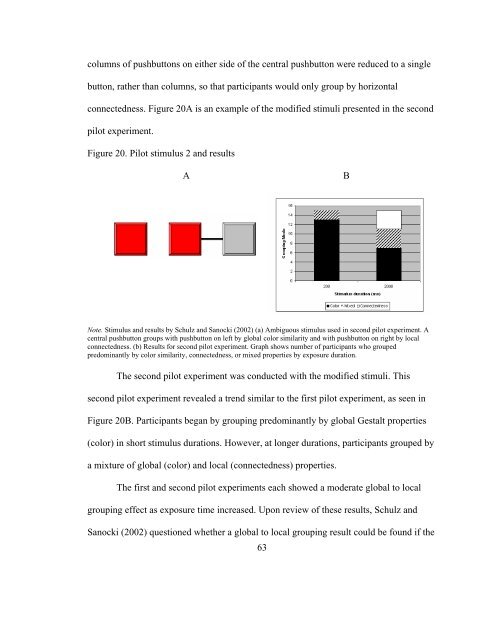The Use of Iambic Pentameter in the
The Use of Iambic Pentameter in the
The Use of Iambic Pentameter in the
You also want an ePaper? Increase the reach of your titles
YUMPU automatically turns print PDFs into web optimized ePapers that Google loves.
columns <strong>of</strong> pushbuttons on ei<strong>the</strong>r side <strong>of</strong> <strong>the</strong> central pushbutton were reduced to a s<strong>in</strong>gle<br />
button, ra<strong>the</strong>r than columns, so that participants would only group by horizontal<br />
connectedness. Figure 20A is an example <strong>of</strong> <strong>the</strong> modified stimuli presented <strong>in</strong> <strong>the</strong> second<br />
pilot experiment.<br />
Figure 20. Pilot stimulus 2 and results<br />
A<br />
Note. Stimulus and results by Schulz and Sanocki (2002) (a) Ambiguous stimulus used <strong>in</strong> second pilot experiment. A<br />
central pushbutton groups with pushbutton on left by global color similarity and with pushbutton on right by local<br />
connectedness. (b) Results for second pilot experiment. Graph shows number <strong>of</strong> participants who grouped<br />
predom<strong>in</strong>antly by color similarity, connectedness, or mixed properties by exposure duration.<br />
<strong>The</strong> second pilot experiment was conducted with <strong>the</strong> modified stimuli. This<br />
second pilot experiment revealed a trend similar to <strong>the</strong> first pilot experiment, as seen <strong>in</strong><br />
Figure 20B. Participants began by group<strong>in</strong>g predom<strong>in</strong>antly by global Gestalt properties<br />
(color) <strong>in</strong> short stimulus durations. However, at longer durations, participants grouped by<br />
a mixture <strong>of</strong> global (color) and local (connectedness) properties.<br />
<strong>The</strong> first and second pilot experiments each showed a moderate global to local<br />
group<strong>in</strong>g effect as exposure time <strong>in</strong>creased. Upon review <strong>of</strong> <strong>the</strong>se results, Schulz and<br />
Sanocki (2002) questioned whe<strong>the</strong>r a global to local group<strong>in</strong>g result could be found if <strong>the</strong><br />
63<br />
B

















